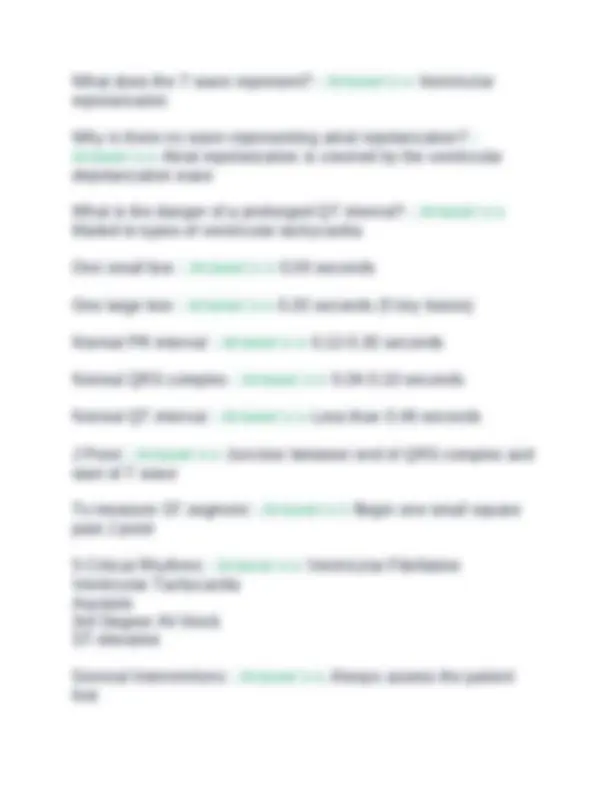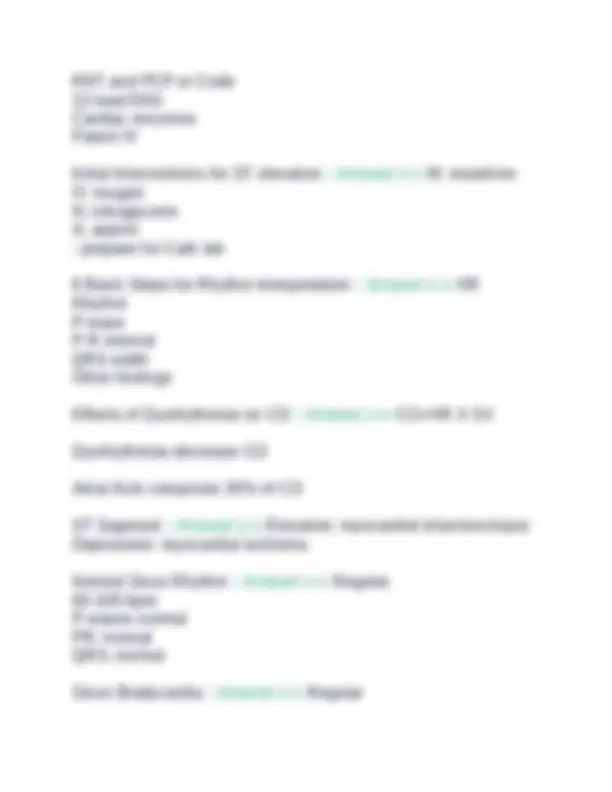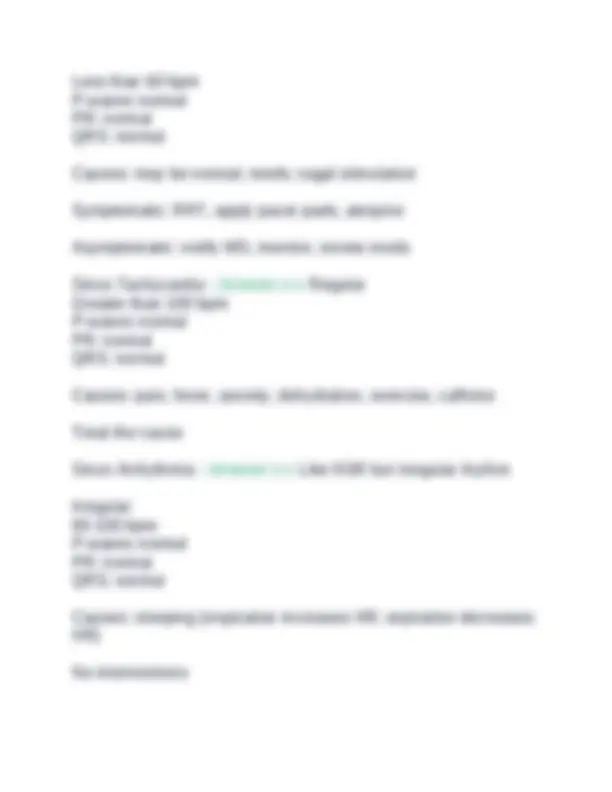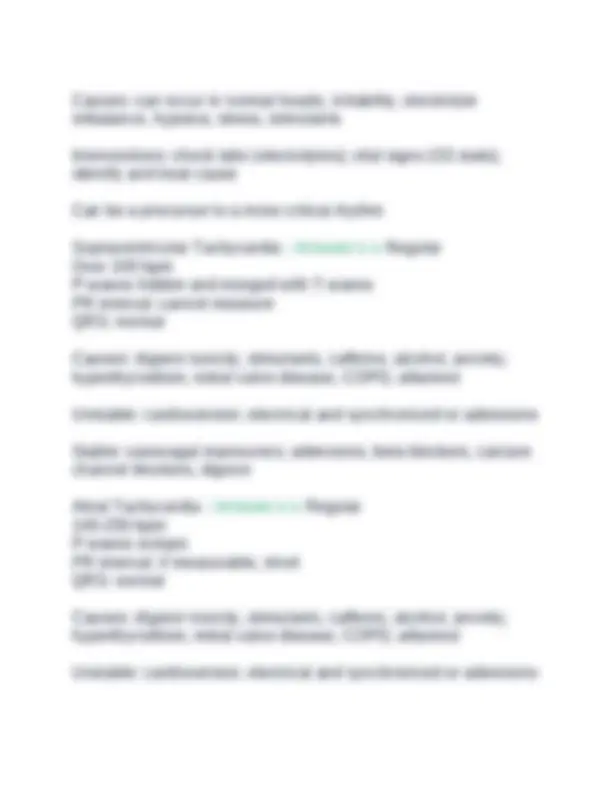








Study with the several resources on Docsity

Earn points by helping other students or get them with a premium plan


Prepare for your exams
Study with the several resources on Docsity

Earn points to download
Earn points by helping other students or get them with a premium plan
Community
Ask the community for help and clear up your study doubts
Discover the best universities in your country according to Docsity users
Free resources
Download our free guides on studying techniques, anxiety management strategies, and thesis advice from Docsity tutors
A comprehensive overview of dysrhythmia exam questions and answers. It covers the flow of conduction in the heart, the parts of the conduction system, av block management, the special qualities of the heart, normal heart rates, ecg wave interpretations, critical rhythms, general and initial interventions, rhythm interpretation steps, the effects of dysrhythmias on cardiac output, st segment analysis, and detailed explanations of various cardiac arrhythmias including sinus rhythms, atrial fibrillation, atrial flutter, premature atrial contractions, supraventricular tachycardia, atrial tachycardia, junctional rhythms, bundle branch blocks, av blocks, ventricular arrhythmias, and pacemaker-related topics. This resource is designed to help healthcare professionals, particularly nursing and medical students, prepare for exams and enhance their understanding of cardiac electrophysiology and dysrhythmia management.
Typology: Exams
1 / 10

This page cannot be seen from the preview
Don't miss anything!







David Mungai [Date] [Course title]
What is the flow of conduction in the heart? - Answer>> SA Node --> AV Node --> Bundle of His --> Purkinje fibers Identify the parts of the conduction system - Answer>> Left side: SA node, AV node, Right bundle branch Right side: Bundle of His, Left bundle branch, Left anterior division, Left posterior division In which AV block should we use Atropine with caution? - Answer>> 2nd degree TYPE 2 What is the special quality of the heart in relation to other muscles in the body? - Answer>> The heart generates its own electrical impulses What is the normal HR when the SINUS node is in charge of heart conduction? - Answer>> 60-100 bpm What is the normal HR when the AV node is in charge of heart conduction? - Answer>> 40-60 bpm What is the normal HR when the Purkinje Fibers is in charge of heart conduction? - Answer>> 20-40 bpm What does the P-wave represent? - Answer>> Atrial depolarization What does the QRS complex represent? - Answer>> Ventricular depolarization
RRT and PCP or Code 12-lead EKG Cardiac enzymes Patent IV Initial Interventions for ST elevation - Answer>> M: morphine O: oxygen N: nitroglycerin A: aspirin
Less than 60 bpm P-waves normal PR: normal QRS: normal Causes: may be normal; meds; vagal stimulation Symptomatic: RRT, apply pacer pads, atropine Asymptomatic: notify MD, monitor, review meds Sinus Tachycardia - Answer>> Regular Greater than 100 bpm P-waves normal PR: normal QRS: normal Causes: pain, fever, anxiety, dehydration, exercise, caffeine Treat the cause Sinus Arrhythmia - Answer>> Like NSR but irregular rhythm Irregular 60-100 bpm P-waves normal PR: normal QRS: normal Causes: sleeping (inspiration increases HR; expiration decreases HR) No interventions
Symptomatic: RRT, 12-lead EKG, crash cart, pads and leads, O2, patent IV Asymptomatic: notify MD, new/historical, 12-lead EKG if rhythm change, controlled/uncontrolled Treatment: A, B, 3C, D
Causes: can occur in normal hearts, irritability, electrolyte imbalance, hypoxia, stress, stimulants Interventions: check labs (electrolytes); vital signs (O2 stats), identify and treat cause Can be a precursor to a more critical rhythm Supraventricular Tachycardia - Answer>> Regular Over 100 bpm P-waves hidden and merged with T-waves PR interval: cannot measure QRS: normal Causes: digoxin toxicity, stimulants, caffeine, alcohol, anxiety, hyperthyroidism, mitral valve disease, COPD, albuterol Unstable: cardioversion; electrical and synchronized or adenosine Stable: vasovagal maneuvers; adenosine, beta blockers, calcium channel blockers, digoxin Atrial Tachycardia - Answer>> Regular 140-250 bpm P-waves ectopic PR interval: if measurable, short QRS: normal Causes: digoxin toxicity, stimulants, caffeine, alcohol, anxiety, hyperthyroidism, mitral valve disease, COPD, albuterol Unstable: cardioversion; electrical and synchronized or adenosine
Intrinsic Pacemakers - Answer>> Indications for Cardiac Pacing - Answer>> Types of Pacemakers - Answer>> Right Atrial Pacing - Answer>> Right Ventricular Pacing - Answer>> Atrial and Ventricular Pacing - Answer>> Atrial, RV, and LV (Bi-ventricular) Pacing - Answer>> Pacemaker Connection - Answer>> Pacemaker Output - Answer>> Pacemaker Capture - Answer>> Pacemaker Sensitivity - Answer>> Pacemaker Problems - Answer>> How to analyze a paced strip - Answer>>